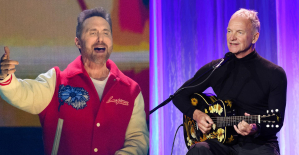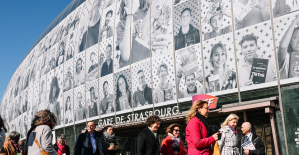Simonetta Sommaruga is a trained pianist, Ueli Maurer, accountant, and Guy Parmelin farmer and winemaker. Three of the seven current members of the enjoyed a non-academic vocational education and training. This is not unusual. Since 1848, only 17 of the previous 119 of the Federal councilors and Federal councillors show no academic degree.
It is also a first indication that the government is already prepared before the election next Wednesday as versatile as seldom before. Whether Regula Rytz added to this is the first green councillor – or not. First, as many Non-represented academics in the state government.
In 1892, were sitting with the new Burger, and a skilled engraver, Numa Droz, the Zurich-based businessman, Walter Hauser, and Basel, Emil Frey, a Major in the US civil war, three men in the Federal Council, which had no academic training.
The Internet turns everything upside down
There is between the end of the 19th century. Century and the present time, further Parallels. Both eras are characterized by technological upheavals. It was electrified in the period from 1890 to 1900, the Switzerland completely. Today, the digitalization and the Internet make everything on the head. And, as then, the emerging Catholic-Conservative, the predecessor of the CVP, it urged to be a part of the Federal Council, today it is the Greens, who want to join the government.
Consequently, the main question at the Federal Council elections on Wednesday: To the Green part of the Swiss government? For the time being, the answer of the Parliament is probably: no.
This is not to say, however, that the Federal Council represents the people is worse, than was previously the case. In the Federal Council election, only the party not to play to strengthen a role. Does today also the gender of the Candidates or their origin. Subconscious factors such as education, age or social background may play a role.
worldwide, There are only four countries, ruled by a collegial authority: in addition to the Switzerland, Bosnia and Herzegovina, San Marino and Andorra. All of these States claim that the government is compensated for busy. The Switzerland manages since 1848, not always, not only in the strength of the parties.
origin I
Particularly, according to the French call, each speaking cantons and the Ticino, according to a representation in the Federal Council. With Success. The Canton of neuchâtel has so far made nine members, six more than you might think due to the size of the population. The Canton of Vaud has fifteen members, eleven it should have been, would be the distribution of the fair; the Ticino was eight instead of five.
The Canton Aargau, in the Federal Council, the main losers are sitting. The Canton introduced since 1848, only five Federal councillors. Extrapolated to the population of the Canton was supposed to come at nine. For justice the number of official working days off premises but. This has to do with the long terms of office of the Aargau to. The FDP members of the Edmund Schulthess (1912 to 1935) and Emil Welti (1867 to 1891) were both significantly more than twenty years in office. Doris Leuthard, CVP, was twelve years of Federal councillor. The term of office of a Federal Council is, on average, ten years. CVP-President Gerhard Pfister proposed this week to limit the Federal Council's term of office to eight years.
origin II
The poor representation of the Canton of Aargau and the Canton of Basel-Landschaft is also reflected in a comparison of the large regions – probably a fairer comparison than that of the cantons. Many of the cantons, which are spatially close, have similar political and social structures. In the Central part of Switzerland, for example.
When comparing the large regions: The North-West of Switzerland, came to significantly less to train than you might expect due to the size of the population. The Region has only eight members. Sixteen might have been expected.
Lukas Golder from the opinion research Institute GFS in Bern says: "The resources of the country between Berne and Zurich, has developed much too long to not have its own identity and not a political strategy." Since the Expo.02 he observed, however, a change. Especially the Aargau present with more Humor and self-confidence. The Canton could celebrate a new Federal councillor, or a newly elected Federal Council, it would be for the population of Aargau are an important sign that the work on the new Canton-identity paid.
age
In contrast to the gender and the origin of the Federal councils, the age no explicit role in the Federal Council election. That Federal councillors are older than the population average, it is understandable. The election of the Federal Council is the culmination of many a political career.
But the changing age structure means that there has been over the decades between the average age of the Bundesrat and that of the population convergence. Although Federal councillors were to 1848 in section, often younger than 50 years. Today, you go to the 60. However, the average age of the Swiss population has risen in the same time from under 30 to nearly 45 years.
gender
From the women's right to vote until the election of the first Federal councillor, it took thirteen years. On 2. October 1984, was elected to the then Zurich FDP national councillor, Elisabeth Kopp as the first woman with 124 of 244 votes in the first ballot in the Bundesrat. Only on 12. December 2007 at the election of Eveline Widmer-Schlumpf of the BDP, were women for the first time, with three representatives reasonably fair in the Bundesrat represented.
More women than there were men in the Federal Council only once: from 2010 to 2011, although in Switzerland, according to the Federal office for statistics, around 80'000 more women than men live. With a large probability will be changed on Wednesday nothing. The green candidate Regula Rytz is likely to prevail, can hardly Ignazio Cassis of the FDP. May Rytz also going to be competing against FDP councillor Karin Keller-Sutter.
family and education
The look on the family Background of the Federal Council shows that social mobility in Switzerland is so pronounced, as this has been since 1848 never the case. In the course of the 19th century. Century it was the rule that the majority of the Federal councillors came from the social Elite. They came either from the influence of academics or politicians, rich families, and were wealthy. After the end of the Second world war, there were on average only three or four members of the family started due to a certain projection of their political career.
Today, only two Federal councillors, who enjoyed, at best, family-due to a small lead in the initial policy sitting in Bern. Alain Berset is a descendent of an influential Fribourg SP-family. Viola Amherds parents resulted in the largest electric trading business of the Brig, with about 100 employees and were active CVP-members.
All the others have worked in a less wealthy environment, or from a political distant circles high: Ignazio Cassis is the son of an immigrant farmer's family. Simonetta Sommaruga grew up in Sins AG as one of four children in a typical middle class family. Karin Keller-Sutter was born in a rural, Catholic Milieu; Ueli Maurer grew up in the vicinity of Hinwil, ZH, made a commercial apprenticeship, and the book was later holder; Guy Parmelin led to the parental farm. Federal councillors such as Kaspar Villiger, who come from a rich industrialist family, are now the exception.
the policy
The most important factor in the Federal Council election are to strengthen the Party in the Parliament. Although the Green could purely claim of the party to the size of a Federal Council seat, it is in the historical Trend, if you don't get. Despite the collegial principle of the recomposition of the Federal Council is lagging behind the changes in party strengths in the Parliament, often for decades.
The most poorly represented in the Federal Council in the 1870s, the Parliament. After the sonderbund war, the Catholic-Conservatives – operated the predecessor of the CVP as an Opposition. The Federal Council was composed exclusively of representatives of the FDP together. In 1891 the first Non-FDPler, the Catholic conservative Joseph Zemp, a Federal Council was granted a seat. In the 1920s and 30s, the social Democrats won regularly the largest percentage share of the vote. Nevertheless, you have been granted only in the year 1943, a Federal Council post.
clearly seen as the magic formula introduced in 1959, (2 FDP, 2 CVP, 2 VPS, 1 SVP), the Federal Council has to represent the party strengths in the Parliament is suddenly better. In the Trend of the electorate is in the composition of the Federal Council, but since 1959, successively less important. Should not be chosen on Wednesday the Green Rytz in the Federal Council, continues this Trend.
This Text is from the current issue. Now all of the articles in the E-Paper of the Sunday newspaper, read: App for iOS App for Android – Web-App

 His body naturally produces alcohol, he is acquitted after a drunk driving conviction
His body naturally produces alcohol, he is acquitted after a drunk driving conviction Who is David Pecker, the first key witness in Donald Trump's trial?
Who is David Pecker, the first key witness in Donald Trump's trial? What does the law on the expulsion of migrants to Rwanda adopted by the British Parliament contain?
What does the law on the expulsion of migrants to Rwanda adopted by the British Parliament contain? The shadow of Chinese espionage hangs over Westminster
The shadow of Chinese espionage hangs over Westminster What High Blood Pressure Does to Your Body (And Why It Should Be Treated)
What High Blood Pressure Does to Your Body (And Why It Should Be Treated) Vaccination in France has progressed in 2023, rejoices Public Health France
Vaccination in France has progressed in 2023, rejoices Public Health France Food additives suspected of promoting cardiovascular diseases
Food additives suspected of promoting cardiovascular diseases “Even morphine doesn’t work”: Léane, 17, victim of the adverse effects of an antibiotic
“Even morphine doesn’t work”: Léane, 17, victim of the adverse effects of an antibiotic Collection of booklet A stalls in March
Collection of booklet A stalls in March Kering expects a 40 to 45% drop in operating profit in the first half
Kering expects a 40 to 45% drop in operating profit in the first half Smartphones, televisions, household appliances… MEPs adopt a “right to repair”
Smartphones, televisions, household appliances… MEPs adopt a “right to repair” Fintechs increasingly focused on business services
Fintechs increasingly focused on business services The standoff between the organizers of Vieilles Charrues and the elected officials of Carhaix threatens the festival
The standoff between the organizers of Vieilles Charrues and the elected officials of Carhaix threatens the festival Strasbourg inaugurates a year of celebrations and debates as World Book Capital
Strasbourg inaugurates a year of celebrations and debates as World Book Capital Kendji Girac is “out of the woods” after his gunshot wound to the chest
Kendji Girac is “out of the woods” after his gunshot wound to the chest The Court of Auditors scrutinizes the management and projects of the Center Pompidou
The Court of Auditors scrutinizes the management and projects of the Center Pompidou Skoda Kodiaq 2024: a 'beast' plug-in hybrid SUV
Skoda Kodiaq 2024: a 'beast' plug-in hybrid SUV Tesla launches a new Model Y with 600 km of autonomy at a "more accessible price"
Tesla launches a new Model Y with 600 km of autonomy at a "more accessible price" The 10 best-selling cars in March 2024 in Spain: sales fall due to Easter
The 10 best-selling cars in March 2024 in Spain: sales fall due to Easter A private jet company buys more than 100 flying cars
A private jet company buys more than 100 flying cars This is how housing prices have changed in Spain in the last decade
This is how housing prices have changed in Spain in the last decade The home mortgage firm drops 10% in January and interest soars to 3.46%
The home mortgage firm drops 10% in January and interest soars to 3.46% The jewel of the Rocío de Nagüeles urbanization: a dream villa in Marbella
The jewel of the Rocío de Nagüeles urbanization: a dream villa in Marbella Rental prices grow by 7.3% in February: where does it go up and where does it go down?
Rental prices grow by 7.3% in February: where does it go up and where does it go down? Europeans: “All those who claim that we don’t need Europe are liars”, criticizes Bayrou
Europeans: “All those who claim that we don’t need Europe are liars”, criticizes Bayrou With the promise of a “real burst of authority”, Gabriel Attal provokes the ire of the opposition
With the promise of a “real burst of authority”, Gabriel Attal provokes the ire of the opposition Europeans: the schedule of debates to follow between now and June 9
Europeans: the schedule of debates to follow between now and June 9 Europeans: “In France, there is a left and there is a right,” assures Bellamy
Europeans: “In France, there is a left and there is a right,” assures Bellamy These French cities that will boycott the World Cup in Qatar
These French cities that will boycott the World Cup in Qatar Football: VAFC supporters are ironic after their descent into National
Football: VAFC supporters are ironic after their descent into National Tennis: Carlos Alcaraz should play in Madrid
Tennis: Carlos Alcaraz should play in Madrid Football: victim of discomfort in the middle of a match in mid-April, Evan Ndicka will resume training with AS Roma
Football: victim of discomfort in the middle of a match in mid-April, Evan Ndicka will resume training with AS Roma Ligue 1: PSG almost champion, OM, shock for the C1… 5 reasons to follow an exciting evening
Ligue 1: PSG almost champion, OM, shock for the C1… 5 reasons to follow an exciting evening


















